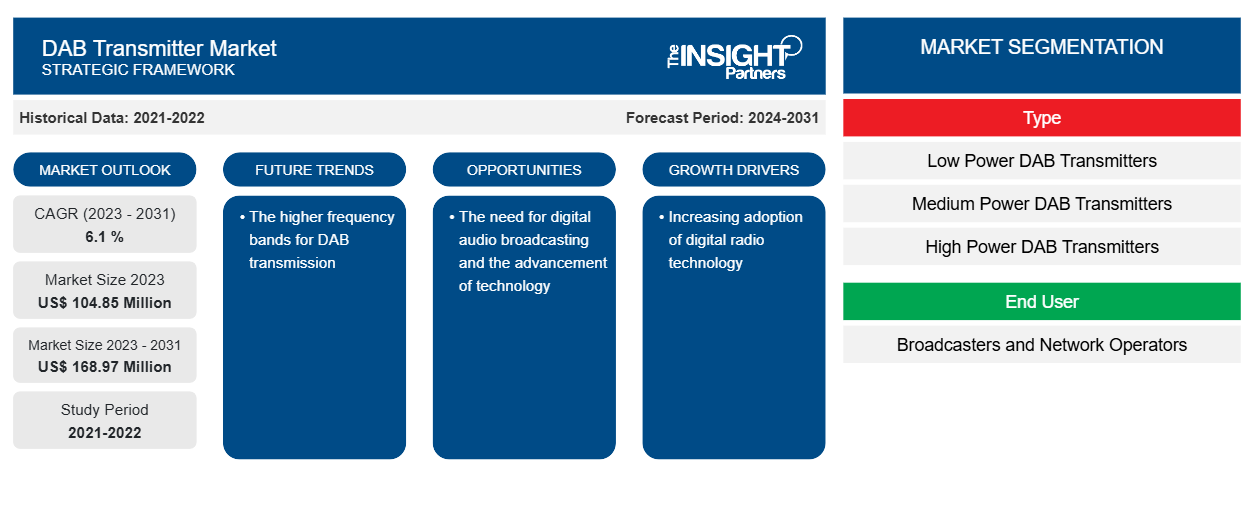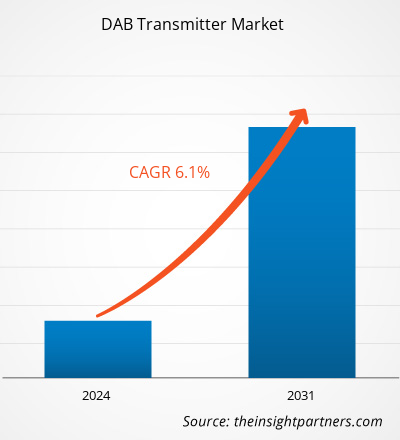The DAB transmitter market is projected to reach US$ 168.97 million by 2031 from US$ 104.85 million in 2023. The market is expected to register a CAGR of 6.1 % during 2023–2031. The higher frequency bands for DAB transmission are likely to remain a key trend in the market.
DAB Transmitter Market Analysis
The global DAB transmitter market is mostly driven by the rising adoption of drones in a variety of applications such as surveying, mapping, and monitoring. Additionally, the increasing number of start-up businesses is driving the expansion of the DAB transmitter market globally. Also, with a DAB radio, users can receive all radio stations, and users are no longer dependent on reception. Thus, the need for digital audio broadcasting and the advancement of technology is anticipated to generate lucrative opportunities for market growth during the forecasted period.
DAB Transmitter Market Overview
Digital Audio Broadcasting (DAB) technology enables broadcasters to transmit high-quality digital audio and data services to mobile and stationary receivers in the Very High Frequency (VHF) bands while facilitating multiple radio stations to share transmission costs by broadcasting on the same frequency using a single transmitter. DAB is an upgraded version of the DAB transmitter, which offers better audio quality, more efficient spectrum usage for additional services, and more robust reception.
Customize This Report To Suit Your Requirement
You will get customization on any report - free of charge - including parts of this report, or country-level analysis, Excel Data pack, as well as avail great offers and discounts for start-ups & universities
DAB Transmitter Market: Strategic Insights

-
Get Top Key Market Trends of this report.This FREE sample will include data analysis, ranging from market trends to estimates and forecasts.
DAB Transmitter Market Drivers and Opportunities
Increasing adoption of digital radio technology
DAB uses higher frequencies than FM, and thus, there can be a need to compensate with more transmitters to accomplish the same coverage as a single FM transmitter. A Various company normally transmits DAB from the broadcaster, who then sells the capacity to several number of radio stations. A DAB tuner can also be used as a Bluetooth speaker and an alarm clock radio. With a DAB radio, users can receive all radio stations, and users are no longer dependent on reception. Several modern radio stations are also switching to DAB. So they can no longer receive them via an FM radio.
The need for digital audio broadcasting and the advancement of technology
The need for high-quality digital audio is growing, as the DAB system can provide a range of data services, including detailed daily broadcast schedules, visual slideshows, and crucial traffic updates, which encompass information about traffic events, parking, public transport, and electric vehicles. Also, the need for advanced technology is increasing. Various technologies are used in using DAB transmitters, such as incorporating the latest RF combiner technology, unbalancing dummy loads, and an intelligent intercommunication interface between RF modules, drivers, and a Logical Control System. Thus, the need for digital audio broadcasting and the advancement of technology is anticipated to generate lucrative opportunities for market growth during the forecasted period.
DAB Transmitter Market Report Segmentation Analysis
Key segments that contributed to the derivation of the DAB transmitter market analysis are type and end user.
- Based on the type, the DAB transmitter market is divided into low-power DAB transmitters, medium-power DAB transmitters, and high-power DAB transmitters. The mini quad segment held a larger market share in 2023.
- By end user, the market is segmented into broadcasters and network operators.
DAB Transmitter Market Share Analysis by Geography
The geographic scope of the DAB transmitter market report is mainly divided into five regions: North America, Asia Pacific, Europe, Middle East & Africa, and South & Central America.
North America dominates the DAB transmitter market. Digital audio advertising enables North American advertisers to access digital audio advertising channels across the region. Companies in the US and Canada can gain national advertising coverage and can take advantage of their native advertising format through podcasts. These investments and funding are expected to help SAB transmitter providers expand their businesses and provide solutions to end users from various sectors. The growing demand for drones propels digital audio in North America, which is likely to benefit the DAB transmitter market in the region.
DAB Transmitter Market Regional Insights
The regional trends and factors influencing the DAB Transmitter Market throughout the forecast period have been thoroughly explained by the analysts at The Insight Partners. This section also discusses DAB Transmitter Market segments and geography across North America, Europe, Asia Pacific, Middle East and Africa, and South and Central America.
DAB Transmitter Market Report Scope
| Report Attribute | Details |
|---|---|
| Market size in 2023 | US$ 104.85 Million |
| Market Size by 2031 | US$ 168.97 Million |
| Global CAGR (2023 - 2031) | 6.1 % |
| Historical Data | 2021-2022 |
| Forecast period | 2024-2031 |
| Segments Covered |
By Type
|
| Regions and Countries Covered |
North America
|
| Market leaders and key company profiles |
|
DAB Transmitter Market Players Density: Understanding Its Impact on Business Dynamics
The DAB Transmitter Market is growing rapidly, driven by increasing end-user demand due to factors such as evolving consumer preferences, technological advancements, and greater awareness of the product's benefits. As demand rises, businesses are expanding their offerings, innovating to meet consumer needs, and capitalizing on emerging trends, which further fuels market growth.

- Get the DAB Transmitter Market top key players overview
DAB Transmitter Market News and Recent Developments
The DAB transmitter market is evaluated by gathering qualitative and quantitative data post primary and secondary research, which includes important corporate publications, association data, and databases. A few of the developments in the DAB transmitter market are listed below:
- DAB+ digital radio broadcasting has better coverage in Spiš. Towercom launched another new transmitter this month, namely Rudnik, located near the Branisko tunnel. The launch took place a few days after receiving the license. Based on the issued license, the transmitter distributes on channel 5C with a maximum permitted power of 1 kW in vertical polarization. This is the third DAB+ transmitter that has been launched this month. (Source: Towercom, Press Release, July 2023.)
- Muxnet UK, which works with local broadcasters and community groups to help them launch small-scale DAB multiplexes, marked the milestone 50th multiplex launch by noting the rapid pace of deployment of small-scale DAB over the past two years. (Source: Muxnet UK, Press Release, March 2024)
DAB Transmitter Market Report Coverage and Deliverables
The “DAB Transmitter Market Size and Forecast (2021–2031)” report provides a detailed analysis of the market covering below areas:
- DAB transmitter market size and forecast at global, regional, and country levels for all the key market segments covered under the scope
- DAB transmitter market trends as well as market dynamics such as drivers, restraints, and key opportunities
- Detailed PEST/Porter’s Five Forces and SWOT analysis
- DAB transmitter market analysis covering key market trends, global and regional framework, major players, regulations, and recent market developments
- Industry landscape and competition analysis covering market concentration, heat map analysis, prominent players, and recent developments in the DAB transmitter market
- Detailed company profiles
Frequently Asked Questions
What is the expected CAGR of the DAB transmitter market?
What would be the estimated value of the DAB transmitter market by 2031?
What are the future trends of the DAB transmitter market?
Which are the leading players operating in the DAB transmitter market?
What are the driving factors impacting the DAB transmitter market?
Which region dominated the DAB transmitter market in 2023?
- Historical Analysis (2 Years), Base Year, Forecast (7 Years) with CAGR
- PEST and SWOT Analysis
- Market Size Value / Volume - Global, Regional, Country
- Industry and Competitive Landscape
- Excel Dataset
Recent Reports
Testimonials
Reason to Buy
- Informed Decision-Making
- Understanding Market Dynamics
- Competitive Analysis
- Identifying Emerging Markets
- Customer Insights
- Market Forecasts
- Risk Mitigation
- Boosting Operational Efficiency
- Strategic Planning
- Investment Justification
- Tracking Industry Innovations
- Aligning with Regulatory Trends





















 Get Free Sample For
Get Free Sample For